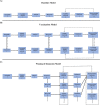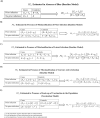Estimating protection afforded by prior infection in preventing reinfection: applying the test-negative study design
- PMID: 38061757
- PMCID: PMC11145912
- DOI: 10.1093/aje/kwad239
Estimating protection afforded by prior infection in preventing reinfection: applying the test-negative study design
Abstract
The COVID-19 pandemic has highlighted the need to use infection testing databases to rapidly estimate effectiveness of prior infection in preventing reinfection ($P{E}_S$) by novel severe acute respiratory syndrome coronavirus 2 (SARS-CoV-2) variants. Mathematical modeling was used to demonstrate a theoretical foundation for applicability of the test-negative, case-control study design to derive $P{E}_S$. Apart from the very early phase of an epidemic, the difference between the test-negative estimate for $P{E}_S$ and true value of $P{E}_S$ was minimal and became negligible as the epidemic progressed. The test-negative design provided robust estimation of $P{E}_S$ and its waning. Assuming that only 25% of prior infections are documented, misclassification of prior infection status underestimated $P{E}_S$, but the underestimate was considerable only when > 50% of the population was ever infected. Misclassification of latent infection, misclassification of current active infection, and scale-up of vaccination all resulted in negligible bias in estimated $P{E}_S$. The test-negative design was applied to national-level testing data in Qatar to estimate $P{E}_S$ for SARS-CoV-2. $P{E}_S$ against SARS-CoV-2 Alpha and Beta variants was estimated at 97.0% (95% CI, 93.6-98.6) and 85.5% (95% CI, 82.4-88.1), respectively. These estimates were validated using a cohort study design. The test-negative design offers a feasible, robust method to estimate protection from prior infection in preventing reinfection.
Keywords: COVID-19; SARS-CoV-2; effectiveness; mathematical model; reinfection; test-negative design.
© The Author(s) 2024. Published by Oxford University Press on behalf of the Johns Hopkins Bloomberg School of Public Health.
Conflict of interest statement
A.A.B. has received institutional grant funding from Gilead Sciences unrelated to the work presented in this paper. The other authors declare no conflicts of interest.
Figures






References
Publication types
MeSH terms
Supplementary concepts
Grants and funding
LinkOut - more resources
Full Text Sources
Medical
Miscellaneous

